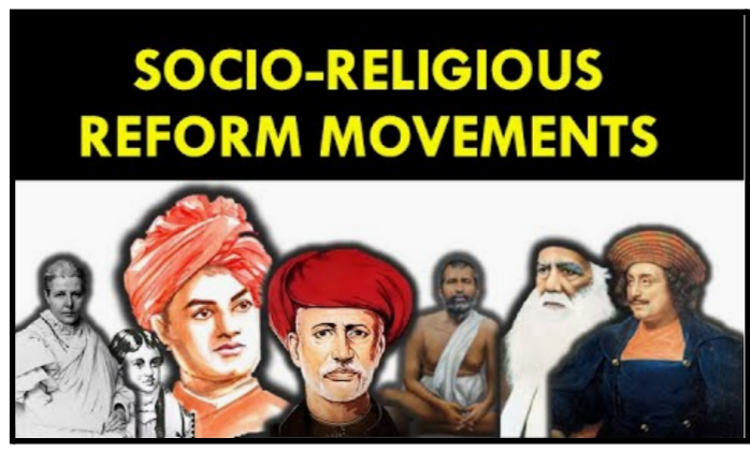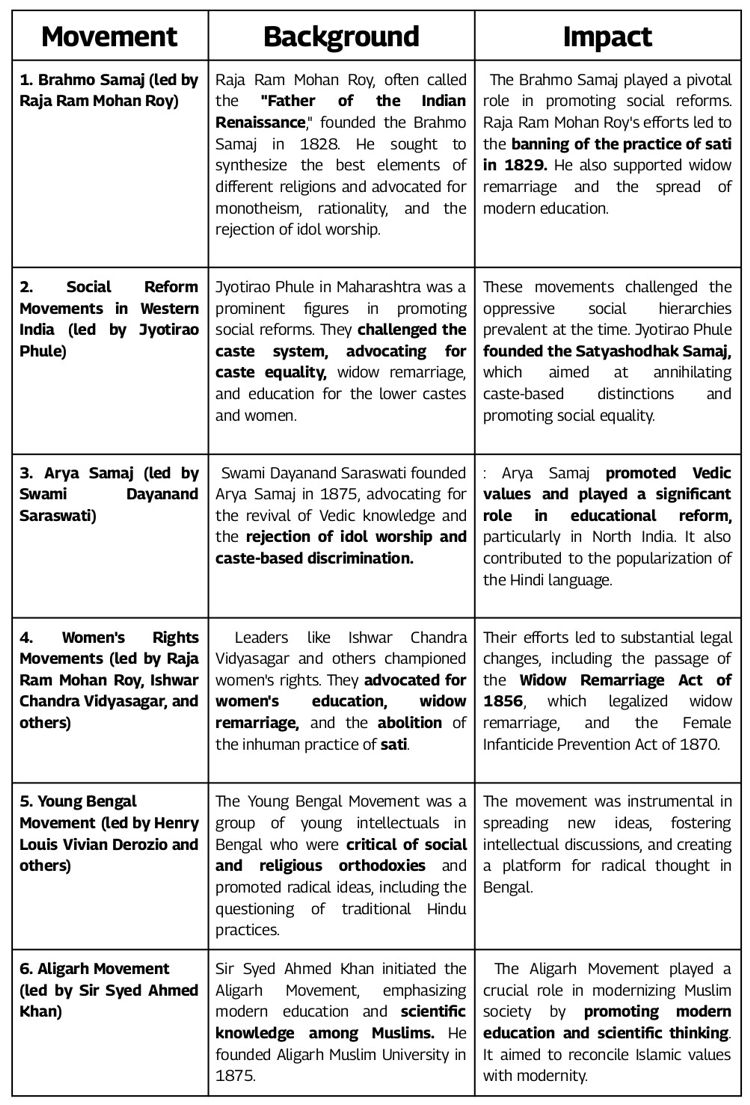
GS-1 History of Modern India
About
Introduction
The 19th century was a time of significant socio-religious transformation in India. The Indian society was characterized by various customs, traditions, and practices rooted in centuries of tradition. These practices often perpetuate social inequalities, gender discrimination, and superstitions. Against this backdrop, various reform movements emerged to challenge these practices and bring about progressive changes.
Background
India in the 19th century was under British colonial rule, which had a profound impact on its socio-religious fabric. The encounter with Western ideas and education led to increased awareness about social issues and a desire for reform. The following are some of the prominent socio-religious reform movements of the time:
Some prominent Movements

The socio-religious reform movements in 19th-century India had profound significance, bringing about transformative changes in Indian society. These movements challenged deep-rooted social and religious customs, advocating for equality, rationality, and modernization. Here's a detailed look at their significance and the British response:
Significance of Socio-Religious Reform Movements:
The socio-religious reform movements in 19th-century India had profound significance, bringing about transformative changes in Indian society. These movements challenged deep-rooted social and religious customs, advocating for equality, rationality, and modernization.
- Eradication of Regressive Practices:
- Sati Abolition: Raja Ram Mohan Roy and Ishwar Chandra Vidyasagar played instrumental roles in the abolition of the practice of sati. The Bengal Sati Regulation Act of 1829 and other legislations marked a turning point in women's rights and the eradication of a barbaric tradition.
- Widow Remarriage: The reformers' advocacy for widow remarriage, supported by legislation like the Widow Remarriage Act of 1856, gave widows the right to marry again, challenging the societal stigma against them.
- Child Marriage: Efforts were made to raise the legal marriage age for girls, combating child marriages.
- Promotion of Education:
Leaders like Jyotirao Phule and Savitribai Phule, Ishwar Chandra Vidyasagar, and Sir Syed Ahmed Khan advocated for education for all, irrespective of caste and gender. The establishment of schools, colleges, and universities, such as Aligarh Muslim University, helped spread modern education.
- Social Equality and Caste Reforms:
Jyotirao Phule, through the Satyashodhak Samaj, and leaders like B. R. Ambedkar later in the 20th century, contributed to caste-based reforms and the annihilation of caste hierarchies. Reformers challenged the untouchability system and advocated for equal rights and opportunities for the lower castes.
- Promotion of Rationality and Scientific Temper:
The Arya Samaj, founded by Swami Dayanand Saraswati, emphasized the importance of reason and rejected idol worship. Modernization efforts led to the spread of Western scientific thought and rationalism.
- Interfaith Dialogue and Unity:
The movements fostered interfaith dialogue, emphasizing commonalities and harmony among different religious communities. Leaders like Raja Ram Mohan Roy and Swami Vivekananda promoted tolerance and religious understanding.
LImitations of the movements
While the socio-religious reform movements of 19th-century India achieved significant progress and brought about important changes, they also had certain weaknesses and limitations. Here are some of the weaknesses associated with these movements:
- Limited Reach and Urban Focus:
Many of the reform movements primarily had influence in urban areas and among the educated elite. They often struggled to gain traction in rural or less-educated segments of society. This limited reach hindered their ability to bring about widespread change. For instance, the Brahmo Samaj, founded by Raja Ram Mohan Roy, was centered in Calcutta (now Kolkata) and had less impact in rural regions.
- Resistance to Change:
Indian society in the 19th century was deeply rooted in centuries-old customs and traditions. Conservative sections of society resisted change, and there was significant opposition to the reformers' efforts. This resistance to change often impeded the progress of reform movements. For example, efforts to abolish practices like sati or child marriage faced strong opposition from traditionalists.
- Intra-Movement Differences:
Within some reform movements, there were internal divisions and disagreements among leaders about the direction and priorities of the movement. These differences sometimes hindered the collective efforts to bring about change. For instance, the Brahmo Samaj experienced divisions between the Brahmo Samaj of India and Adi Brahmo Samaj factions.
- Dependency on Colonial Support:
In certain instances, reformers relied on the support of the British colonial authorities to push through legal reforms. While this was a means to achieve their objectives, it raised concerns about the authenticity and self-sufficiency of the reform movements. For example, the Widow Remarriage Act of 1856, while a significant achievement, was passed with colonial support.
- Failure to Address Economic Inequalities:
Many of the reform movements primarily focused on social and religious issues and did not adequately address economic inequalities. In the 19th century, India faced significant economic disparities, with poverty and land ownership issues prevalent. These issues were often not the central focus of reform movements, leaving a gap in their scope and thus not being able to gain mass support.
Conclusion
In summary, the socio-religious reform movements of the 19th century had a profound impact on Indian society, leading to the eradication of regressive practices, the promotion of education, social equality, and the fostering of interfaith dialogue. The British response was complex, reflecting their colonial interests and the challenges of maintaining control over a rapidly changing society. These reform movements set the stage for the social and political changes that would culminate in the Indian independence movement.


